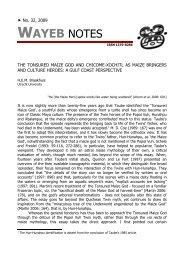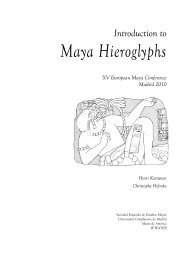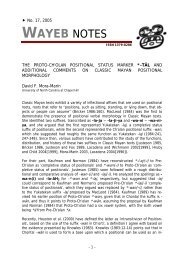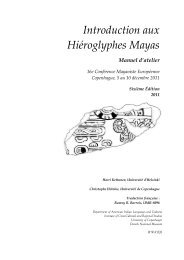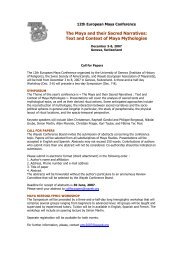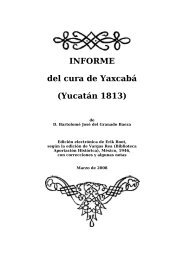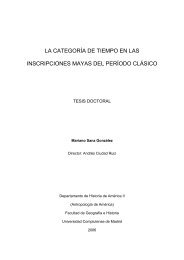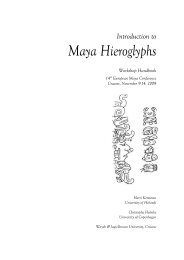Introduction to Maya Hieroglyphs - Wayeb
Introduction to Maya Hieroglyphs - Wayeb
Introduction to Maya Hieroglyphs - Wayeb
You also want an ePaper? Increase the reach of your titles
YUMPU automatically turns print PDFs into web optimized ePapers that Google loves.
Kettunen & Helmke 2011<br />
Glossary of Linguistic Terminology<br />
cognate<br />
Sets of words are cognates (in related languages) if they derive from the same original word. Normally cognates<br />
have similar PHONOLOGICAL and SEMANTIC structures, but exceptions <strong>to</strong> this rule are numerous and can only be<br />
detected by his<strong>to</strong>rical linguistics. The word for “bee” and “honey” is chab in Ch’ol, Ch’ontal, Ch’orti’, Ch’olti’, and<br />
Tzeltal; kab in Yukatek, Lakandon, Itza’, and Mopan; and kaab in K’iche’, Kaqchikel, and Tzutujil; but they all stem<br />
from Pro<strong>to</strong>-<strong>Maya</strong> *kaab, and they are, therefore, cognates of a same word. The longer the distance of related<br />
languages is (in time and space) the more easily words of same origin tend <strong>to</strong> vary. For example, the word for<br />
“hundred” varies a great deal in different Indoeuropean languages through time and space: in Latin it is centum,<br />
in Greek hekatón, in Old Irish cēt, in Gothic hund, in Swedish hundra, in Tokarian känt, in Spanish cien<strong>to</strong>, in Sanskrit<br />
śatám, in Lithuanian šimtas, and in Russian s<strong>to</strong>, but they are all cognates of Pro<strong>to</strong>-Indoeuropean *kmtóm. Words<br />
also change semantically in different related languages, and also inside a language in time: for example, the word<br />
nice meant stupid and foolish in the late 13th century English. The word went through a number of changes<br />
including extravagant, elegant, strange, modest, thin, and shy ending up <strong>to</strong> its current meaning in the 18th century.<br />
Considering the his<strong>to</strong>ry of <strong>Maya</strong> languages (and reconstructing Classic <strong>Maya</strong> or Pro<strong>to</strong>-<strong>Maya</strong> languages) one has<br />
<strong>to</strong> consider both phonological and semantic changes in the languages that are not and were no more constant or<br />
stable than any other languages in the world.<br />
consonant<br />
One of the two significant classes of sounds (besides VOWELS). Consonants are produced by greater constriction or<br />
by a complete closure of the airstream in the speech organs than for vowels. The result is either friction or<br />
complete obstruction of the air. Generally consonants do not form syllables alone (without a vowel). In linguistics<br />
the capital letter C usually stands for a(ny given) consonant.<br />
context dependence<br />
Context dependence means that the interpretation (or translation) of an expression depends on the context in<br />
which it is used; be it literary, syntactical or otherwise.<br />
contrast<br />
Two sounds contrast (or the PHONETIC distinction is contrastive) if replacing one with the other (in an identical<br />
phonetic context) changes the meaning of a given word. For example, /l/ and /r/ are two distinctive PHONEMES in<br />
English: if you were <strong>to</strong> change the /l/ in “lock” <strong>to</strong> an /r/, you would get a different word, “rock” (in Japanese, for<br />
example, there is no distinction between these phonemes). Such pairs of words whose meaning can be contrasted<br />
on the basis of a phoneme are called MINIMAL PAIRS. In Classic <strong>Maya</strong> there existed phonemic distinctions that are<br />
less familiar among native English speakers. One of them is the opposition between (BI)LABIAL, dental/ALVEOLAR,<br />
and VELAR STOPS or PLOSIVES (i.e. /p/, /t/, and /k/) on one hand, and GLOTTAL s<strong>to</strong>ps or plosives (/p’/, /t’/, and /k’/) on<br />
the other (included is also the opposition between words with or without preconsonantal or inter-vowel glottal<br />
s<strong>to</strong>ps (’). Consider the following examples: kab (earth, land) and k’ab (hand); chan (sky, snake, 4) and cha’n<br />
(guardian). Another distinction is made between short and long vowels: nah (first) in contrast <strong>to</strong> naah (house,<br />
structure). Yet another distinction is made between words with or without preconsonantal velar or glottal<br />
FRICATIVES: k’an (ripe, yellow) and k’ahn (stair, bench). In the glyphic texts the vowel length and the<br />
preconsonantal velar and glottal fricatives are not directly detectable, and consequently they have <strong>to</strong> be<br />
reconstructed.<br />
deictic pronoun<br />
A pronoun whose reference must be fixed through the context of the utterance. See also DEIXIS below:<br />
deixis<br />
Elements in a language may have a reference which is dependent on the immediate (generally extralinguistic)<br />
context of their utterance. For example, personal and demonstrative PRONOUNS, spatial expressions (e.g. “here”<br />
and “there”), temporal expressions (e.g. “<strong>to</strong>morrow” and “now”), tense (past, present, etc.), and gestures of the<br />
speaker are deictic expressions.<br />
133/154



